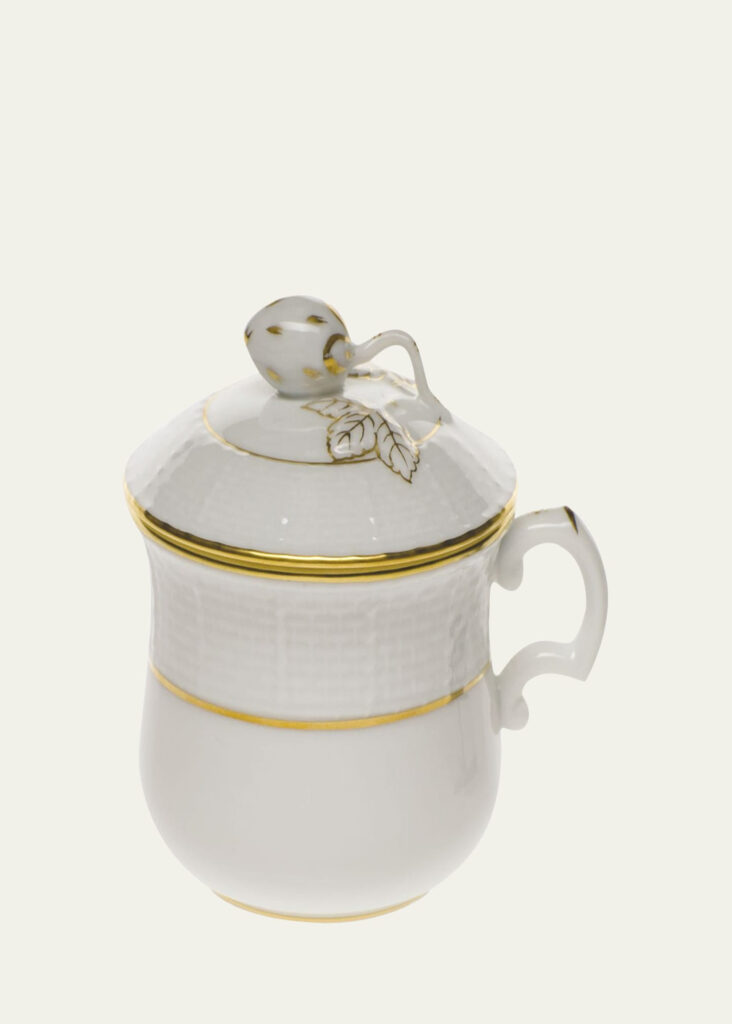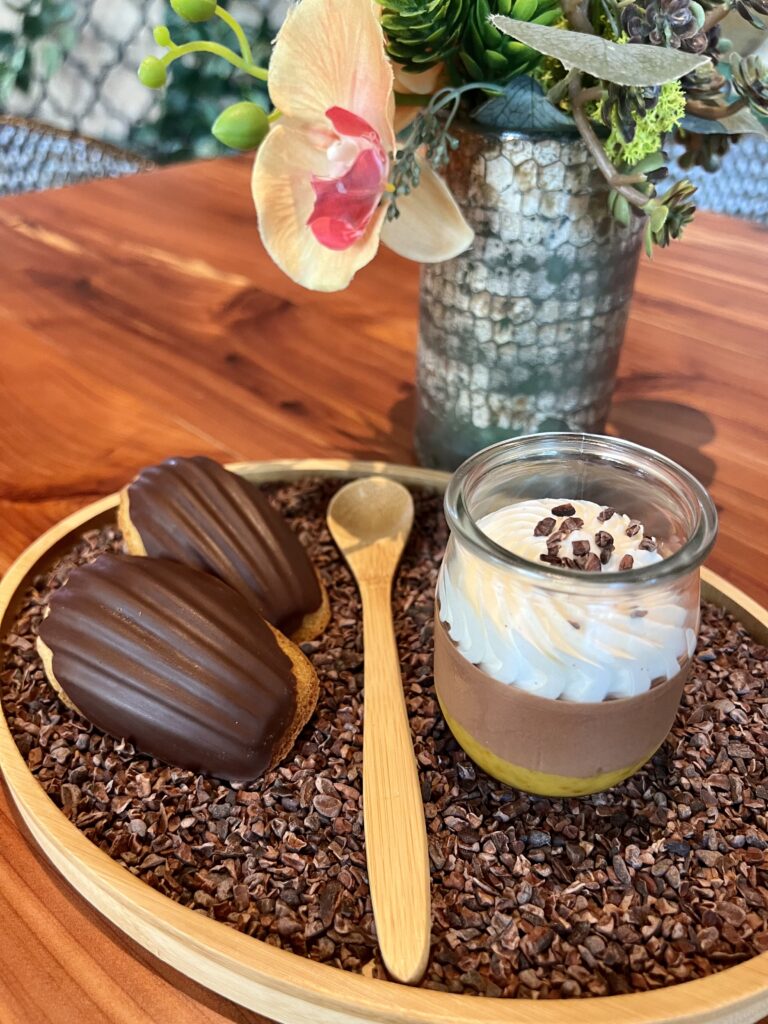Pots de crème is a classic French dessert with a rich history dating back to the 17th century. According to The Oxford Companion to Sugar and Sweets, In France, a small porcelain dish of chocolate mousse is sometimes called a pot de crème, but that dessert is more accurately custard. The difference is that for custard, the eggs are not whipped but thickened by the slow addition of scalded milk or cream (and flavorings) and poured into ramekins that are then poached in a water bath in a slow oven.”
Here’s a detailed account of its origins, evolution, and enduring appeal:
Origins in 17th Century France
Pots de crème first appeared in French cuisine during the 1600s. The name literally translates to “pots of cream” or “pots of custard,” referring to both the dessert itself and the small porcelain containers in which it was traditionally served.
Early Preparation and Serving
Initially, pots de crème was used as a pie filling. However, it soon evolved into a standalone dessert served in small portions without a crust. By the 17th century, specially crafted porcelain cups called “pots de crème” or “petits pots” (small pots) were designed specifically for serving these custards.
Pots de Crème Pots
The Cottage Journal’s article, “The History Behind the Pots de Crème Pots,” written by Bethany Adams, delves into the history and charm of the pot de crème cup, a small, elegant porcelain vessel traditionally used to serve the French dessert “pots de crème.” Originating in the 18th century, these cups were designed specifically for the creamy custard dessert. The article explains that these cups, typically about 3″ in height, were often made of porcelain and featured intricate designs, with lids to keep the dessert fresh. The pot de crème cup was not just functional but also a symbol of status and luxury, often found in aristocratic households.

“From the mid-1700s to the early 1900s, some of the finest examples [of pots] came from Sèvres, Meissen, Wedgewood, and Worcester,” writes Adams.
Over time, the dessert and its cups became popular across Europe and eventually in America, where they remain a cherished part of culinary history.
Adams further discusses how the popularity of pots de crème, both the dessert and the cup, has endured through the centuries, maintaining a special place in both professional kitchens and home baking. The article highlights the resurgence of interest in these cups, which are now considered collectible items, valued for their beauty and historical significance. The pot de crème’s association with refinement and tradition continues to captivate dessert enthusiasts, making it a beloved classic in the world of fine dining and home entertaining.
Traditional Ingredients and Preparation
The basic recipe for pots de crème has remained relatively consistent over the centuries. It typically includes:
- Eggs or egg yolks
- Cream or milk
- Sugar
- Flavoring (often vanilla or chocolate)
The dessert is traditionally baked in a water bath at a low temperature to achieve its signature smooth and creamy texture.
Cultural Significance
Pots de crème became a staple in French households and fine dining establishments. Its simplicity and elegance made it a popular choice for both everyday meals and special occasions. The dessert was often served on formal European and American tables during the 18th and 19th centuries.
Evolution and Variations
While vanilla and chocolate remained the most common flavors, chefs and home cooks began experimenting with various ingredients over time. Coffee, caramel, fruit, and other flavorings were introduced to create new variations of the classic dessert.
Modern Popularity
In recent years, pots de crème has seen a resurgence in popularity, particularly among those who appreciate traditional pastry-making techniques. Its versatility and rich texture continue to make it a favorite for both professional chefs and home bakers.
Cultural Impact
The dessert’s influence extends beyond its culinary appeal. The term “pot de crème” has become synonymous with small, decorative porcelain cups used for serving various desserts. These cups, often featuring delicate designs and lids with finials, have become collectible items in their own right.
Pots de crème remains a beloved dessert that embodies the elegance and artistry of French cuisine. Its enduring popularity is a testament to its timeless appeal and the skill required to create the perfect custard texture.
National Pots de Crème Day
Aug. 27 is celebrated as National Pots de Crème Day, a delightful occasion dedicated to this classic French custard dessert. Known for its rich, creamy texture and versatility, pots de crème is a culinary treasure that has captivated dessert lovers for centuries.
Celebrating National Pots de Crème Day
On National Pots de Crème Day, dessert enthusiasts are encouraged to indulge in this timeless treat. Whether you prefer the classic vanilla flavor or want to experiment with variations like chocolate, coffee, or fruit-infused pots de crème, the possibilities are endless. Many bakeries and restaurants also join in the celebration by offering special pots de crème options on their menus.
Chef Rabii Saber’s Recipe
To honor this special day, we are featuring a recipe from our team’s logistics co-director, former 2017 team member, and Executive Pastry Chef Four Seasons Resort Orlando at Walt Disney World® Resort, Chef Rabii Saber. His expertise and passion for pastry shine through in this delectable pots de crème recipe, however, he elevates it with an orange confit spread and a vanilla mascarpone cream. And if that wasn’t enough, pillowy soft madeleines are served on the side.
Spiced Orange Chocolate Pot de Crème
Yield: 12 servings

Chocolate Mousse Recipe
Yield: 1,090g
| INGREDIENTS | MEASUREMENTS |
| STEP ONE | |
| Heavy cream | 125g |
| Milk | 125g |
| Egg yolks (we used Vital Farms) | 50g |
| Granulated sugar (we used Domino) | 25g |
| TOTAL ANGLAISE | 325g |
| Note: Scale the anglaise for the recipe below | |
| STEP TWO | |
| Crème Anglaise | 300g |
| Dark chocolate, chopped (we used Dominican Republic 62%) | 340g |
| Whipped cream | 450g |
INSTRUCTIONS:
- In one bowl add the egg yolks and granulated sugar. Whisk until mixture turns pale yellow (2-3 minutes). Set aside.
- Add the milk and cream in a heavy medium stainless steel pot and place over a medium-low heat and bring to a simmer.
- Slow pour one-third of the hot milk/cream mixture into the egg yolk mixture. Stirring constantly. Add remaining milk/cream mixture.
- Return the pot to the stove and cook – stirring constantly – until the mixture registers 82 degrees celsius/180 degrees fahrenheit.
- Remove from the bowl from the heat and measure out 300g of the anglaise.
- Pour the hot anglaise mixture over the chopped chocolate. Stir with a spatula until well mixed. Let the mixture cool down to 40 degrees celsius/104 degrees fahrenheit.
- Using a hand blender, mix until smooth.
- Gently fold in the whipped cream.
Orange Confit Spread Recipe
Yield:
| INGREDIENTS | MEASUREMENTS |
| Orange peel | 500g |
| Orange pulp | 250g |
| Raw sugar | 500g |
| Cinnamon stick | 10g |
| Star anise | 5g |
INSTRUCTIONS:
- Peel the oranges and cut the peels in julienne.
- Place the orange peels in 3 liters of water for 24-hours.
- Strain the peels and blanche them in hot water.
- Repeat the process for 3 times.
- In a pot, place the blanched peels, spices, orange pulp and sugar.
- Cook on low heat for 2h, until the orange peels are tender.
- Remove the spices and place the orange peels in food processor and pulse it until slightly chunky or smooth – depending on preference.
Madeleines Recipe
Yield: 50-60 each
| INGREDIENTS | MEASUREMENTS |
| Granulated sugar (we used Domino) | 250g |
| Honey | 100g |
| Whole eggs (we used Vital Farms) | 375g |
| All-purpose flour (we used King Arthur Baking Company – flour) | 500g |
| Baking powder | 10g |
| Baking soda | 10g |
| Milk, whole | 180g |
| Pure vanilla extract (we used Nielsen-Massey Madagascar Vanilla) | 30g |
| Unsalted butter, melted | 310g |
| Fresh lemon zest | 4 medium lemons (10g of zest) |
INSTRUCTIONS:
- Lightly grease the madeleine pan, set aside (NOTE: you can use a traditional metal madeleine pan, however if you want to chocolate coat one side of them as in this recipe it’s best to start with a silicone madeleine mold).
- In a small mixing bowl, whisk eggs, honey, and sugar.
- Mix in milk, vanilla extract, and lemon zest.
- Sift all dry ingredients together.
- In a bowl or mixer, in three batches – gradually alternate the dry and liquid ingredients together either by hand or mixer.
- Temper some of the mix into the butter (50-degree Celsius) and mix. Then add the remaining mixture into the butter and gently fold together. The batter should be thick, silky, and shiny.
- Pipe batter or spoon (approx: 1 Tablespoon) of batter into the madeleine molds and bake at
325 degrees fahrenheit for 10-12 minutes. - The madeleines are done when the tops spring back after lightly pressed with your finger. You should also see a bump or dimple in the center. Invert the pan onto a wire rack to lightly cool.
Chocolate for Madeleines
- Thoroughly clean and dry the madeleine pan or mold. Set aside.
- Temper one pound (16 oz/454g) of Dark chocolate (we used Dominican Republic 62%)
- Place approximately 1 – 1 1/2 teaspoons of tempered chocolate in each of the madeleine molds.
- Place one madeleine in each mold (shell side down) and gently press. Place the mold in the freezer or refrigerator for approximately 5 minutes until the chocolate is set.
- Gently remove the madeleines from the mold.
- Store in an airtight container.
Vanilla Mascarpone Cream Recipe
Yield: 465g
| INGREDIENTS | MEASUREMENTS |
| Heavy cream | 375g |
| Mascarpone cheese | 60g |
| Confectioners sugar (we used Domino) | 30g |
| Vanilla bean paste or Whole vanilla bean, scraped (we used Nielsen-Massey) | 1.5g 1 ea |
INSTRUCTIONS:
- Place all ingredients into a bow and mix together.
- Whip everything to soft peak.
ASSEMBLING THE DESSERT
Layer One:
Evenly divide the orange confit spread among the 12 ramekins or glasses in the bottom.
Layer Two:
Then do the same for the chocolate mousse layer.
Layer Three:
Pipe a rosette of vanilla mascarpone cream on top and then garnish with Valrhona cocoa nibs.
Place the pots de crème on a dessert plate. Serve with one or two madeleines on the side.
With just a few ingredients and straightforward instructions, you can create a luxurious pots de crème that is sure to impress. Join us in celebrating National Pots de Crème Day by trying out Chef Saber’s recipe and experience the rich flavors and delightful textures that make pots de crème a cherished dessert around the world.